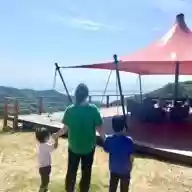[Warabe-uta] Beloved Classic Songs Passed Down Through Generations
Nursery rhymes that have been passed down in Japan since long ago.
There are many types of nursery rhymes, including drawing songs, counting songs, and play songs.
Many of you probably sang and played games like Kagome Kagome and Hana Ichi Monme at least once when you were children.
In this article, we introduce popular nursery rhymes.
If you want to remember the nursery rhymes you sang as a child or enjoy them with your kids, be sure to give them a listen!
- Nostalgic Children’s Songs, Folk Songs, and Nursery Rhymes: The Heart of Japan Passed Down Through Song
- Lullabies: children's songs, folk songs, and nursery rhymes. Nostalgic songs for putting children to sleep.
- Snake Song: Children's song, nursery rhyme, and hand-play song
- Collection of winter nursery rhymes, folk songs, and children's songs. Includes fun winter hand-play songs too.
- Nursery Rhyme Popular Song Rankings [2025]
- A seemingly scary nursery rhyme: a children’s song that gives you the chills when you hear it
- [Minna no Uta] Beloved Across Generations: Nostalgic Classics and Popular Songs
- Nursery rhymes, folk songs, and children's songs about animals
- Folk songs, children’s songs, and nursery rhymes of Kumamoto: the enduring spirit of our hometown passed down through song.
- [February Songs] Introducing children's songs, folk songs, nursery rhymes, and hand-play songs about Setsubun and winter!
- Ministry of Education songs, children's songs, and nursery rhymes. The heart of Japan passed down in song.
- Nursery rhymes and play songs to enjoy with your baby. Gentle children's songs.
- A classic Mother Goose tune. A Mother Goose song that’s popular with children.
[Warabe-uta] Beloved Nostalgic Classics Passed Down in Song (1–10)
Horsetail shoots are poking up.

A masterpiece of children’s song that lets you feel the breath of nature.
Within its simple wordplay, it deftly weaves in the moment when plants sprout, offering the delight of a stroll through spring fields and hills.
More than lofty musical artistry, it’s the easy singability that has kept it beloved for many years.
It’s also enjoyed with hand motions and is widely used in early childhood education settings.
This work beautifully expresses the Japanese sense of the seasons and a heartfelt reverence for nature, making it enjoyable across generations, from children to adults.
Why not sing it together with family and friends, feeling the arrival of a nature-rich spring?
Inside-out pots!

It’s a children’s hand-holding song game.
In time with the song, players do half turns and end up back-to-back, making sure not to let go of each other’s hands.
Then, following the song, they return to the original position at the end.
It’s fun with pairs, of course, but the larger the group, the more complicatedly everyone gets tangled up, which will likely make the kids even more excited.
Many people will notice that the melody is very similar to Kagome Kagome.
In fact, it’s said that Kagome Kagome and Nabe Nabe Soko Nuke may have been made from the same original song.
The Full Moon Man’s mochi poundingchildren’s song

One person takes the role of pounding the mochi, and the other kneads it, singing while clapping their hands.
For the kneading role, it’s important to move their hands rhythmically so they don’t get caught and hit by the pounding role’s hands.
Take turns switching roles and have fun.
[Warabe-uta] Beloved nostalgic songs passed down through generations (11–20)
From inside the bamboo grove

A simple yet rhythmic melody, combined with hand-play and rock-paper-scissors, makes this an ideal song for nurturing children’s imagination and sense of rhythm.
In educational settings, it also helps improve communication skills, and its appeal spans all ages.
Passed down orally, the piece features subtle regional variations that reflect local character and culture—an interesting point in itself.
It is widely used in nursery schools and kindergartens and is beloved as a staple for hand-play songs and rock-paper-scissors games.
Denderaryubachildren’s song

Denderaryūba is a slightly complex and entertaining hand game.
With a mysterious sound that feels like a regional dialect, this piece is a traditional children’s song that has been passed down in Nagasaki Prefecture.
To the chant-like lyrics, you rhythmically change combinations of your knuckles, thumb, and index finger on the palm of your other hand.
Start at a slow pace, and once you can move smoothly, gradually increase the speed.
If you can play it through without mistakes, it’s sure to feel very satisfying.
Two children got into a fight.children’s song

The children’s favorite warabe-uta “Kodomo to Kodomo ga Kenka Shite” centers on the theme of kids fighting, with comical, friendly lyrics that make it memorable.
The song describes a quarrel that a pharmacist tries to stop but just won’t end, playfully portraying everyday life for children.
As a way to play, it features a distinctive motion of tapping fingers in sequence, so babies through preschoolers can enjoy it.
It’s perfect not only for nursery and kindergarten teachers but also for bonding time with parents.
Singing and playing together as a family makes for wonderful memories.
Where are you from?

“Anta-gata Doko sa” is a children’s song set in Kumamoto, Higo Province, on the island of Kyushu.
It’s a classic play-song still used in various recreational activities.
A common way to play is to do an action whenever the syllable “sa” appears in the lyrics.
One popular version—jumping forward on “sa” while hopping sideways—was even featured on the TV show ‘Itō-ke no Shokutaku.
’ Adults might find it fun to play, too.






